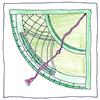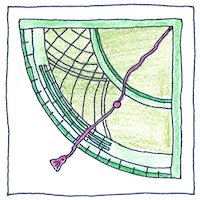Jean Picard
geodesy

|
Surveying the earth
Eratosthenes figured the size of the earth by comparing the lengths of shadows and knowing the distance between Aswan and Alexandria in stadia. Eratosthenes could have been off by as much as sixteen or as little as two percent, depending on how long you think his stadia were. Jean Picard improved surveying instruments, and surveyed the distance of one degree of latitude along the Paris Meridian. The polar radius that Picard calculated was under a half of a percent less than the currently accepted value.
Originals
Picard wasn’t the first or the last to measure a meridian arc. Francesco Maurolico described this method in 1543, and it is thought to have been suggested by Eratosthenes. Gemma Frisius invented triangulation in 1533. Willebrord Snellius (known as Snell) developed the math for measuring by triangulation from city to city in 1617, which he did in an attempt to follow Maurolico’s method, although his result not as accurate as Picard’s. William Gascoigne had invented the micrometer and the telescopic sight with crosshairs in 1638. All Jean Picard did was put it all together. Picard measured his baseline with wooden rods, attached Gascoigne’s telescope and micrometer to a quadrant to measure his angles, used Snell’s math with John Napier’s logarithms in his calculations and achieved enough accuracy to be considered the first modern measurement of the polar radius.
Instruments
If Archimedes had a lever long enough and a fulcrum on which to place it then he could have moved the world. If I had a reason strong enough, a judgment clear enough, a meaning near enough then I could help people put aside their differences and feel compassion for each other. We live on a small fragile world, in which greed has measurable harm and generosity measurable benefit.



Jean Picard corresponded with Huygens, Newton, Ole Rømer who made the Rømer temperature scale, Rasmus Bartholin who discovered birefringence, and Giovanni Cassini, who calculated the distance between Earth and Mars. Picard used Christiaan Huygens’ pendulum clock in measuring the right ascension of celestial objects in 1673, and his measurement of the earth was useful to Isaac Newton in his theory of universal gravitation.
See also in The book of science:
Readings in wikipedia: